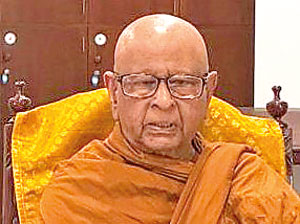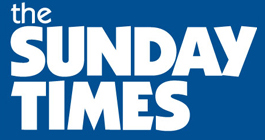Sunday Times 2
A life’s journey to Siri Vajiraramaya Temple
View(s):Ven. Siri Vajiraramaye Ñanasiha Thera is completed his 90th birthday on February 18, 2025. His father and mother were R.G. James Gunasekera of Telijjavila in the Matara District and Seela Gunasekera (nee Wijesinghe) of Vigoda, Bemmulla, in the Gampaha District. His father was a government servant (Dept. TeleCom), and with his duty transfers, the son had to change five schools.
In 1946, he joined Royal College Grade 6 and completed his school life there in 1952. He studiously followed the school motto “Learn or Depart”. He has been getting the Form prizes from the First Form onwards, and his name, R.G.G.O. Gunasekera, is displayed even today in three panels in the main hall of Royal College.
When he entered the University of Ceylon, belonging to the first batch that had complete university education at Peradeniya, he had already successfully completed the London Intermediate Examination. He had his Dhamma education at Vajirarama Dhamma School, where he had the opportunity to be at the feet of the late Most Ven. Pelene Vajirañana Mahanayake Thera and other renowned monks, such as Narada Maha Thera, Ampitiye Sri Rahula, and Piyadassi Maha Theras.
During this period, Ven. Rahula Thera asked whether he would like to get ordained, while Ven. Narada wanted him to pursue his studies at the university and then consider getting ordained. I think Ven. Rahula Thera would have observed the schoolboy Olcott’s Buddhist behavioural pattern that will make him end up as a Buddhist monk.
In 1953, he entered the University of Ceylon, not in Colombo but in the newly constructed garden university campus in Peradeniya. He was in the Faculty of Arts following a four-year special degree. According to the Gazette notification published in 1957, there were six vacancies for that year in the Ceylon Civil Service (CCS). He was so bright to become one of the six in the competitive exam that ensued. His first appointment as a CCS cadet was to the Kandy Kachcheri.
In 1964, when the Asia Foundation prepared a world study tour for late Most Venerable Madiha Paññasiha Mahanayake Thera, he got permission from the Government of Ceylon for him to accompany the Mahanayake Thera as Foster/Translator and leave of absence for 139 days was granted. They embarked from the Colombo harbour by ship to reach Naples and from there by train via Bologna, Innsbruck and Munich to Berlin, and Hamburg, Copenhagen, Paris and London to New York. From New York, there was an extensive study tour from the East to the West coast of the USA by road and rail.
Among many outcomes of this tour were (1) the establishment of the first Theravada Buddhist temple in North America, located in Washington, DC; (2) introducing the concept of a self-denial fund, learning from observations among Mormons in Utah. It was familiarised as the ‘Skip-a-Meal Fund’ by the Dharmavijaya Foundation (DVF), and its collections were used to alleviate malnutrition; and (3) implementing for youth a programme called Turunu Saviya (Youth Strength) to harness youth strength for development purposes, taking a cue from 4H Clubs visited in Chicago.
Instead of having a fashionable wedding in a five-star hotel, he went to the Register General’s Office (RGO), Colombo. Bride Anula came with her relations and their marriage was registered at RGO. In his autobiography ‘Nissarana Yatra’ (page 64) it is mentioned that the Register General at the time was late Sugathadasa Samarasinghe, who was my father.
The Gal Oya Development Board (GODB) was established in 1950 to implement a multipurpose river development scheme, similar to the Tennessee Valley Authority, in the US. After completing the irrigation work and settlements in 1961, the developed area was handed to line agencies. In the process the earlier Batticaloa District was divided into two, namely, Batticaloa and Ampara districts. It is surprising to know that although settlement work was completed a few decades ago, the Mahaweli Authority is still functioning in Mahaweli areas. In the new District of Ampara, Mr. Gunasekera became the third Government Agent (GA) and that was in 1964 when he was 29 years of age. He went to Amapara with three belongings: a newly married wife, his Peugeot 203 car and two suitcases. When in Ampara, he was blessed; his first baby, Ashok, was born in Government Hospital, Batticaloa.
R.G.G.O. (Olcott) Gunasekera had a lengthy association with the Cooperative Movement and could be said to be in three phases. He was firstly, the Commissioner of Cooperative Development and Registrar of Cooperative Societies from 1970 to 1973 and was entrusted to implement the recommendations of the Laidlaw Commission Report under which the 10,000+ small cooperative societies were amalgamated into 323 large multi-purpose cooperative societies. When he retired from government service in 1973 on terms of the abolition of the Ceylon Civil Service, he was 38 years of age. Those days this was the practice among Civil Servants as there was a demand by international agencies for their quality of work and integrity.
Among his social service activities, I would like to single out Mr. Gunasekara’s leadership with Most Ven. late Madihe Mahanayake Thera in establishing DVF on November 8, 1977. He was the founder President and continually served in that capacity for 34 years. The DVF was incorporated by Act of Parliament No. 62 of 1979. The projects of DVF come under seven broad Programmes, namely, (1) Promoting Moral Development (2) Economic (3) Education (4) Health and Wellbeing (5) Workshops and Conferences (6) Training and (7) Media and Communication.
The Board of Trustees of DVF, from its inception, meets for business on every Thursday of a week. These meetings are currently held at the DVF headquarters, constructed during his tenure as President. Some elected life member trustees living abroad are appointed as honorary representatives of DVF. Ranjith Soysa (Australia) and I (Canada) participate in the meetings of the Board of Trustees held on the last Thursday of a month via Zoom. Currently, the Supreme Patron of DVF (Uttara Anusasaka) is Most Ven. Tirkunamale Ananda Mahanayaka Thera.
Mr. Gunasekera, at the age of 79, along with Anula, his companion in life, had a lengthy discussion with Most Ven. Tirkunamale Ananda Mahanayaka Thera about his intentions to get ordained as a Buddhist monk. He expressed that as a Vajirarama Dhamma School student he is anxious to be a resident monk at Siri Vajiraramaya Temple and be guided by the Mahanayaka Thera. He stepped down from all national and international office-bearerships and resigned from memberships and consultancy boards, which were numerous, and became a ‘lay ten-preceptor’; Mr. R.G.G.O. (Olcott) Gunasekera was ordained soon after as Ven. Siri Vajiraramaye Ñanasiha on the Medin full-moon Poya day of March 05, 2015.
During the past ten years as a monk, he has been striving diligently to attain his spiritual goals. He has made very valuable contributions to Siri Vajiraramaya, one of which is the development of the 100-year-old Siri Vajirarama Library.
Our family members would like to take this opportunity to wish Ven. Ñanasiha Thera good health and a successful life as a monk. May he shorten his sansaric life, and may he attain the Supreme Bliss of Nibbana during this life itself. Budu Saranai!
Senaka Samarasinghe
Winnipeg, Canada

